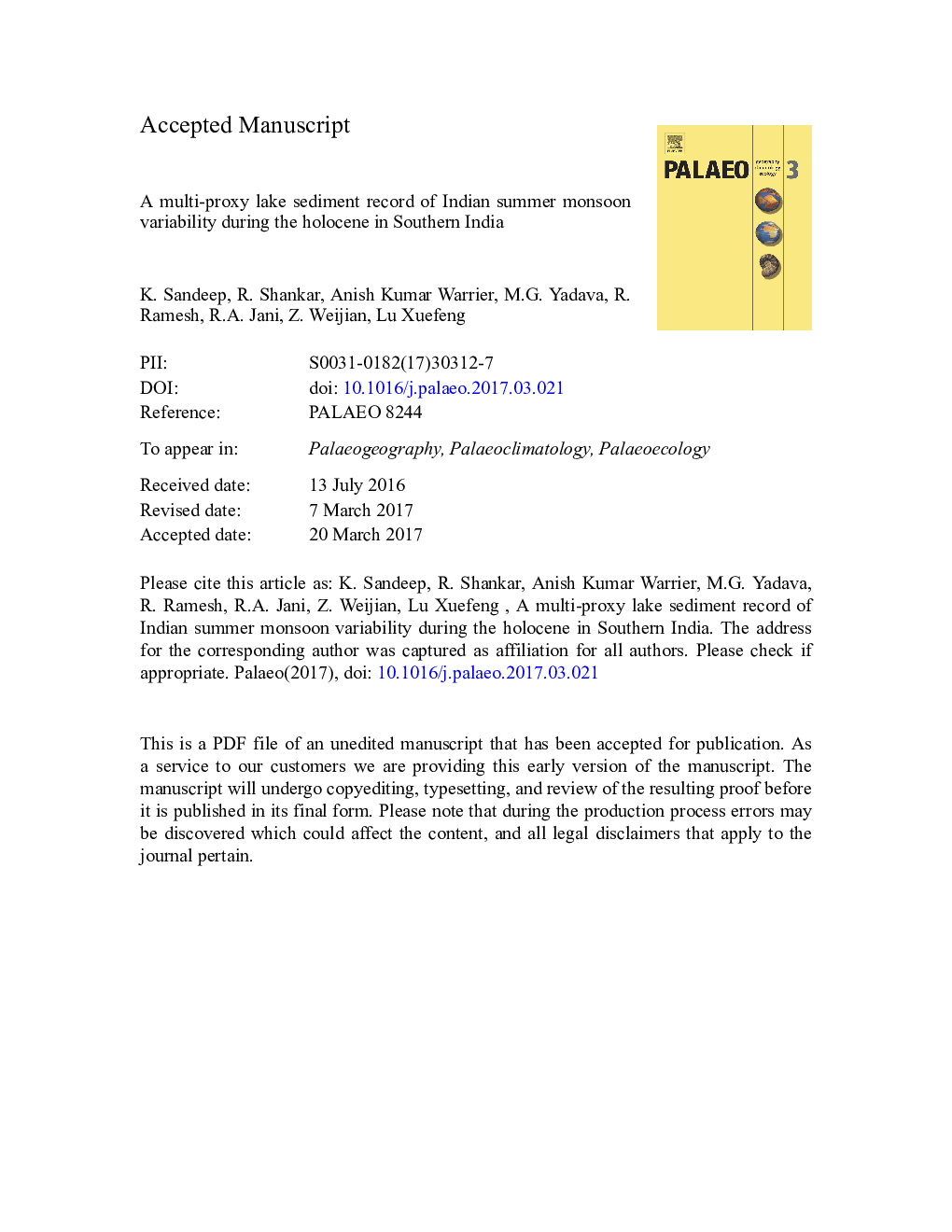| کد مقاله | کد نشریه | سال انتشار | مقاله انگلیسی | نسخه تمام متن |
|---|---|---|---|---|
| 5755881 | 1622116 | 2017 | 47 صفحه PDF | دانلود رایگان |
عنوان انگلیسی مقاله ISI
A multi-proxy lake sediment record of Indian summer monsoon variability during the Holocene in southern India
ترجمه فارسی عنوان
یک رسوب رسوبی دریاچه چند پروکسی تغییرات موسمی تابستان در طول هولوسن در جنوب هند
دانلود مقاله + سفارش ترجمه
دانلود مقاله ISI انگلیسی
رایگان برای ایرانیان
کلمات کلیدی
موضوعات مرتبط
مهندسی و علوم پایه
علوم زمین و سیارات
فرآیندهای سطح زمین
چکیده انگلیسی
We present here an 11,000-year palaeomonsoonal record from a sediment core (SS-1) from Shantisagara (SS) Lake in Peninsular India, which is the longest published so far from the region. This is also a region with limited palaeoclimate records. Environmental magnetic, organic geochemical, sedimentological and carbon isotopic studies were carried out on the SS-1 sediments to reconstruct the Indian summer monsoon (ISM) variability during the Holocene. The chronology of the sediments is constrained by three AMS 14C dates. Environmental magnetic data reveal that there is no contribution from bacterial magnetite, greigite and anthropogenic magnetite/lithogenic grains and that the magnetic signal is contributed mainly by the pedogenic component. The environmental magnetic data also depict variations in pedogenic magnetite production in the catchment and detrital influx to the lake, which in turn is related to monsoonal rainfall amount. The sedimentological data reveal variations in sediment size related to monsoon. The Corg/N ratio and δ13C indicate palaeovegetational variations in the SS catchment. Periods of strong monsoon are characterized by high values of concentration-dependent magnetic parameters like Ïlf, Ïfd, ÏARM and SIRM, high sand content, low Corg/N ratio (fully aquatic-deep water conditions), relatively depleted δ13C values (more C3 but less C4 land plants) and vice versa. The prominent palaeomonsoon events documented in this study are: (i) 11,100-10,700 cal yr BP with a weak ISM, (ii) 10,700 to 8600 cal yr BP characterized by intensified ISM, corresponding to the Early Holocene Optimum, (iii) 8600 to 4500 cal yr BP with a weakened ISM, (iv) 4500 to 3300 cal yr BP characterized by fluctuating monsoonal conditions, (v) 3300 cal yr BP to the Present with a slight increasing trend in ISM. A similar pattern is also documented in many palaeomonsoon records from the region, which indicate that Shantisagara sediments were able to record regional climatic variations as well.
ناشر
Database: Elsevier - ScienceDirect (ساینس دایرکت)
Journal: Palaeogeography, Palaeoclimatology, Palaeoecology - Volume 476, 15 June 2017, Pages 1-14
Journal: Palaeogeography, Palaeoclimatology, Palaeoecology - Volume 476, 15 June 2017, Pages 1-14
نویسندگان
K. Sandeep, R. Shankar, Anish Kumar Warrier, M.G. Yadava, R. Ramesh, R.A. Jani, Z. Weijian, Lu Xuefeng,
